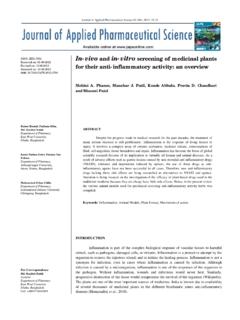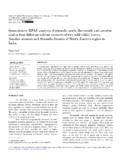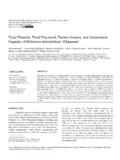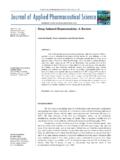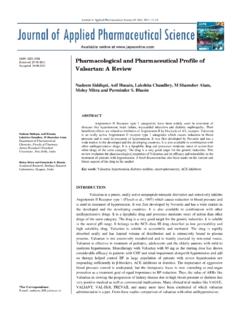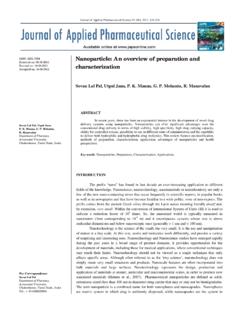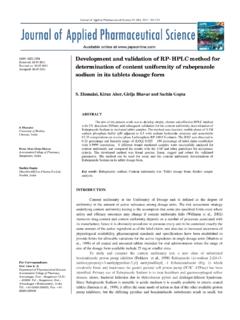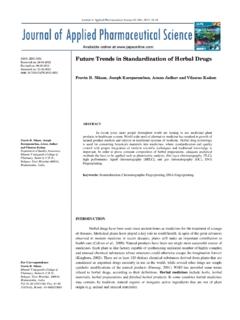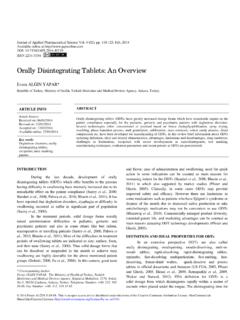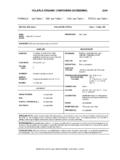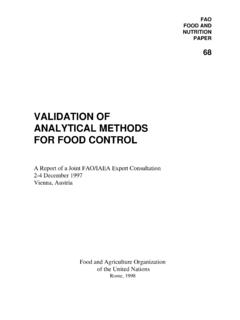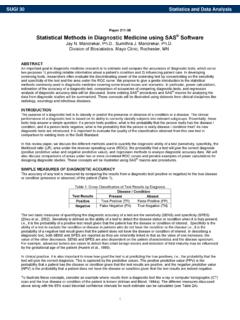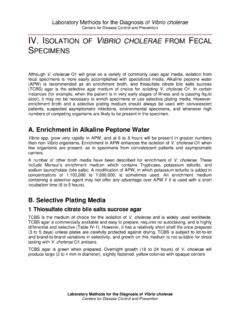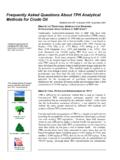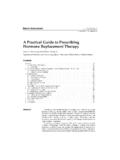Transcription of Isolation and screening of extracellular proteases ...
1 Journal of Applied Pharmaceutical Science Vol. 2 (9), pp. 071-074, September, 2012 Available online at DOI: ISSN 2231-3354 Isolation and screening of extracellular proteases produced by new Isolated Bacillus sp Hanan S. Alnahdi Department of Biochemistry, Faculty of Girls Science, King Abdulaziz University, Jeddah, Saudi Arabia. ARTICLE INFO ABSTRACT Article history: Received on: 10/07/2012 Revised on: 03/08/2012 Accepted on:23/08/2012 Available online: 28/09/2012 Bacterial are well known for their ability to excrete enzymes into the environment. Bacillus sp. being industrially important organisms produces a wide variety of extra-cellular enzymes including proteases .
2 Bacillus sp. isolated from local marine samples collected from Saudi Arabia for produced protease enzyme. The aim of this work was to evaluate protease production by different bacterial isolated from marine. Six bacterial isolates were screened for protease production. Two protease producing isolates, and were selected on the basis of gelatin hydrolyses. When the extracellular protease were examined using fermentation production medium, the date recorded the highest extracellular protease enzyme reached to (243 U/ml) by isolate No. 2. Finally the selected isolate was identify according to the morphological characteristics and named Bacillus sp EHN.
3 Key words: Protease, extracellular , enzyme, screening , isolations. Identification, gelatin ager, Bacillus. Sp INTRODUCTION proteases are a group of enzymes, whose catalytic function is to hydrolyze peptide bonds of proteins and break them down into polypeptides or free amino acids. They constitute 59% of the global market of industrial enzymes, which is expected to exceed $ Billion by 2012 (Deng et al.,2010). They have got wide range of commercial usage in detergents, leather, food and pharmaceutical industries (Bhaskar et al.,2007 and Jellouli et al.,2009). Sources of proteases include all forms of life, that is, plants, animals and microorganisms.
4 Based on their acid-base behavior, proteases are classified in to three groups, that is, acid, neutral and alkaline proteases . Acid proteases performed best at pH range of and are mostly produced by fungi. proteases having pH optima in the range of or around are called neutral proteases .. Neutral proteases are mainly of plant origin. While proteases having optimum activity at pH range of 8 and above are classified as alkaline proteases produced from microorganisms. proteases produced from microorganisms play important role in several industries example detergent, tanning, photographic industries, pharmaceutical and waste treatment etc.
5 (Gupta et al.,2002). proteases are widespread in nature, microbes serve as a preferred source of these enzymes because of their rapid growth, the limited space required for their cultivation and the ease with which they can be genetically manipulated to generate new enzymes with altered properties that are desirable for their various applications (Kocher and Mishra, 2009) Bacillus produces a wide variety of extracellular enzymes, including proteases . Several Bacillus species involved in protease production are B. cereus, B. sterothermophilus, B. mojavensis, B. megaterium and B. Subtilis (Shumi et al.)
6 , 2004). The genus Bacillus is an important source of industrial alkaline proteases and are probably the only genera _____ _____ _____ _____ _____ _____ _____ _____ ____ * Corresponding Author Email: enas 072 Alnahdi / Journal of Applied Pharmaceutical Science 2 (09); 2012: 071-074 being commercialized for alkaline protease production (Ferrari et al.,1993). They are widely distributed in soil and water, and certain strains tolerate extreme environmental conditions including highly alkaline conditions. screening of proteases producing Bacillus sp. from different ecological environments can result in Isolation of new alkaline proteases with unique physiochemical characteristics (Singh et al.
7 ,1999). One of the most important characteristics that determine the industrial suitability of proteases is their requirement of high pH for optimum enzyme activity. In this paper we aimed to isolate newer source of extracellular protease from the local marine sample in Saudi Arabia to potential application of the proteases for industrial applications. MATERIALS AND METHODS Source of samples Samples of sea water and sediment (30-m depth) were collected in sterile containers along the Red Sea coast from Jeddah, Saudi Arabia. Isolation of bacteria Bacteria were isolated for protease enzyme using a serial dilution method described by Sjodahl et al.
8 , (2002). Samples were inoculated on skim milk agar plates containing peptone ( ), NaCl ( ) and skim milk (10%) medium prepared using sea water, then incubated at 28 2 C for three days (Uyar et al.,2011). Bacterial isolates were primarily purified on nutrient agar medium and routinely maintained at 4 C on culture purity was determined from colony morphology. screening for best strain produced protease The isolates were screening for best strain produced protease by plate assay using protease specific medium containing (g/l) K2 HPO4 , , peptone , gelatin , and agars 15. The clear zone diameters were measured after 24h of incubation at 28 C by flooded the plates with mercuric chloride solution, this method was referred as gelatin clear zone method (Abdel Galil 1992).
9 Quantities estimation of protease The isolates strains were inoculated in 50 ml of protease specific medium broth containing (g/L) glucose, ; peptone, ; ( , ; KH2PO4, ; and , 0. 1, and were culture in a rotary shaker (180 rpm) at 28 C for 3 days. After the completion of fermentation, the whole fermentation broth was centrifuged at 10,000 rpm at 4 C, and the clear supernatant was recovered. The crude enzyme supernatant was subjected to further studies (Josephine et al.,2012). Measurement of enzymatic activity Protease activity in the culture supernatant was determined according to the method of Tsuchida et al.)
10 , (1986) by using casein as a substrate. A mixture of 500 l of 1% (w/v) of casein in 50 mM phosphate buffer, pH 7 and 200 l crude enzyme extract were incubated in a water bath at 40 C for 20 minutes. After 20 minutes, the enzyme reaction was terminated by the addition of 1 ml of 10% (w/v) trichloroacetic acid (TCA) and was kept at room temperature for 15 minutes. Then, the reaction mixture was centrifuged to separate the unreacted casein at 10,000 rpm for 5 minutes. The supernatant mixed with ml of Na2CO3. 1 ml of 3-fold diluted Follin Ciocalteus phenol reagent, was adding. The resulting solution was incubated at room temperature in the dark for 30 minutes and absorbance of the blue color developed was measured at 660 nm against a reagent blank using a tyrosine standard (Lowry et al.)
